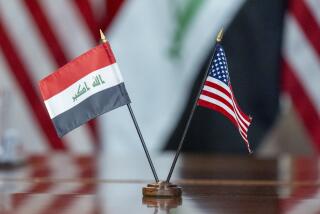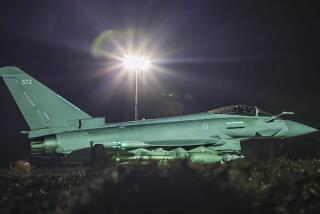U.S. Ground Forces Raid Airport in Assault on Taliban Stronghold
WASHINGTON — The U.S. military assault on Afghanistan entered a new stage today as an assault force, including Army Rangers, attacked the airport in the southern Afghan city of Kandahar, the heart of the Taliban regime, U.S. officials said.
Moving under cover of darkness, a force of more than 100 helicopter-borne troops staged the attack, then withdrew after several hours, a U.S. official said. The force may have included special operations commandos as well as the light infantry Rangers, according to one official.
All the helicopters successfully left Afghan airspace, officials said. Pentagon officials later confirmed that two U.S. military personnel died in a helicopter crash in Pakistan. The copter was part of the military operation. Initial reports were that the helicopter crashed while providing support for the mission but was not part of the raid, although Pentagon officials did not confirm that.
Officials withheld the names of the dead, pending notification of their next of kin.
In Shanghai today, President Bush confirmed the deaths of the soldiers, but he declined to comment on the raid.
“The important thing for me to tell the American people is these soldiers will not have died in vain,” Bush told reporters.
According to Pakistani border patrol sources in Baluchistan province, the helicopter crashed near the village of Chagai, in a mountainous area about 15 miles south of the Afghanistan-Pakistan border where peaks reach as high as 8,000 feet. Chagai is Pakistan’s nuclear testing site.
The crash site was 30 miles from a civil aviation airport in Dalbandin, Pakistan, where sources said U.S. troops had begun landing four days ago. Civil aviation sources said that the Dalbandin site had been sealed off by Pakistani army troops, that U.S. aircraft were taking off and landing there and that “stationary facilities” had been constructed on the tarmac.
In Kabul, Taliban officials were quoted as saying their forces successfully repulsed the raid, with no casualties.
Bush said of the U.S. operation in general: “I am satisfied we are making very good progress. We are dismantling the Taliban defenses. . . . We are destroying terrorists’ hideaways.”
U.S. officials declined to discuss the strike team’s goal. Special operations missions are typically aimed at capturing or killing key figures, or at destroying an important asset, such as a chemical weapons arsenal.
The attack demonstrated that the United States intends to take on the considerable risks of a ground campaign in its effort to track down and destroy the leaders of the Taliban government and Osama bin Laden and his Al Qaeda terrorist network.
The attack was likely the opening move in what will be a series of ground confrontations with a force that, though relatively small, has a fearsome reputation.
Move Designed to Have Maximum Effect
In targeting Kandahar, the assault was clearly calibrated to have maximum effect on the adversary. The United States has in recent days stepped up a psychological campaign intended to frighten the Taliban and Al Qaeda, and to encourage dissident groups to join U.S. forces and their allies in the Afghan opposition.
But the Taliban quickly dismissed the raid’s effectiveness.
“There was no casualty from our side, and, like the aerial attacks, the U.S. commando offensive too has been foiled,” Education Minister Amir Khan Muttaqi told Reuters today.
“Around 12 o’clock [local time] last night several U.S. helicopters carrying commandos landed on Baba Sahib mountain to the west of Kandahar city,” Muttaqi said.
“Simultaneously, the Taliban approached there and forced them to flee back by firing at them,” he said.
The account could not be independently confirmed.
Top U.S. officials have been hinting for days that a ground attack could come soon, and they have acknowledged privately that small Special Forces teams have been moving in the country on reconnaissance and target-selection missions.
Although officials gave few details Friday night, their willingness to leak the outline of the strikes suggested that they want to show Americans and their coalition partners--in the Middle East and elsewhere--that they are serious about what Gen. Richard B. Myers, the Joint Chiefs of Staff chairman, described Thursday as the most important U.S. military mission since World War II.
Army Rangers are customarily used to accompany smaller Special Forces commando teams in assaults. The commandos are highly trained specialists who carry out kidnapping or killing missions. The more heavily armed Rangers provide a valuable backup force, in much the same way that city police patrol officers might accompany SWAT teams.
Rangers worked with Special Forces teams, for example, in the 1993 attacks in Somalia.
Airstrikes Increased Before Ground Attack
Today’s attack came after 12 days of bombardment on Afghanistan. In light of the raid, the increasing pace of airstrikes in recent days suggests that the Pentagon wanted to prepare the way for this ground attack.
Earlier this week, U.S. forces began deploying AC-130 gunships, which pump out cannon and artillery fire at a withering 2,500 rounds per minute and are used to provide cover to special assault teams entering a region.
It was unclear how the U.S. force reached the scene. U.S. special operations teams have recently been aboard the carrier Kitty Hawk, hundreds of miles away from Afghanistan in the Arabian Sea.
Daniel Goure, a former defense official now at the Lexington Institute, said U.S. forces have just received permission to use a base just south of Kandahar on the Pakistani side of the border.
Goure said the attack likely had several goals: to find key figures, to wreak destruction “and to make clear that this will be a war unlike anything the Afghans have seen.”
He said the U.S. forces were taking full advantage of technology that allows them to fight at night against an opponent that lacks such capability.
The U.S. military’s special operations forces includes the Green Berets, Navy SEALs, a clandestine unit called Delta Force and Air Force Air Commandos.
In all, the U.S. has 46,000 special operations troops, with each unit trained to carry out different type of missions by land, sea and air. They include experts at counter-terrorism, reconnaissance and guerrilla warfare. Working in teams of 12, they generally drop from helicopters behind enemy lines.
Military analysts believe that any effort to locate and capture Bin Laden would probably fall to the prestigious Delta Force, which specializes in daring hostage rescues and kidnappings.
In a sign that the entry of perhaps significant numbers of U.S. ground troops into Afghanistan could be imminent, the Pentagon released the transcript of messages broadcast to Afghans from aircraft over the past few days.
Afghans were advised that once U.S. ground forces arrived, the safest place to be in would be their homes.
“Attention. People of Afghanistan, United States forces will be moving through your area. . . . Please, for your own safety, stay off bridges and roadways, and do not interfere with our troops or military operations,” the broadcasts said.
“If you see United States forces, you need to find shelter and not leave it until we have left the area. . . . Your home will be the safest place.”
The broadcasts gave specific instructions on how Taliban troops should surrender.
“When you decide to surrender, approach United States forces with your hands in the air. Sling your weapon across your back, muzzle toward the ground. Remove your magazine and expel any rounds. Doing this is your only chance of survival,” the broadcast said.
The broadcasts vowed to give no quarter to Taliban soldiers and Al Qaeda supporters who did not surrender:
“Attention, Taliban. You are condemned. Did you know that? The instant the terrorists you support took over our planes, you sentenced yourselves to death.”
Also Friday, Defense Secretary Donald H. Rumsfeld acknowledged that the United States has been providing direct assistance to rebel forces fighting Afghanistan’s Taliban regime.
Rumsfeld said the United States is providing the insurgents with food, ammunition and other supplies, the first official confirmation of such aid. He said the United States “from time to time” has furnished what the groups requested, either by funneling the material to them or by providing cash.
His comments came in a discussion with reporters en route to Whiteman Air Force Base in Missouri to meet with Air Force personnel working on the B-2 long-range bombers, and their families. The B-2s, which are flown by the 509th Bomber Wing, have played a key role in the bombing campaign.
Rumsfeld and other defense officials increasingly had spoken of their desire to provide such aid to the rebel groups, but his comments were the first indication that such help already were underway. Since the U.S.-led air attacks on Afghanistan began Oct. 7, Pentagon officials had reported only that repeated bombing strikes were being used to soften up vulnerable Taliban positions.
The Northern Alliance, the remnant of the Afghan government that the Taliban ousted in the mid-1990s, is a sworn enemy of Pakistan, a key U.S. ally in the war on terrorism, as well as the Taliban regime that controlled up to 95% of Afghanistan before the start of the U.S. air war. In meetings with Secretary of State Colin L. Powell this week, Pakistani leaders made it clear that they do not want the Northern Alliance, a coalition of minority ethnic groups, to form the post-Taliban government.
A Northern Alliance official in Uzbekistan said that fighting continued near Mazar-i-Sharif on Friday for control of the strategic city north of Afghanistan’s capital, Kabul. He described the fighting as “major” but said there had been no significant change in the positions held by either side.
He reported that U.S. bombs hit two sites in Mazar-i-Sharif controlled by the Taliban, but there was no indication what was struck or whether there were any casualties.
In Islamabad, the Pakistani capital, Taliban Ambassador Abdul Salam Zaeef said the Afghan regime’s forces had repelled an assault by the Northern Alliance in the suburbs of Mazar-i-Sharif, killing 11 rebel troops and taking 20 prisoners.
Neither version of the fighting could be independently confirmed.
*
Times staff writers Norman Kempster and Esther Schrader in Washington, Edwin Chen in Shanghai, Richard C. Paddock in Tashkent, Uzbekistan, and Rone Tempest in Islamabad contributed to this report.
More to Read
Sign up for Essential California
The most important California stories and recommendations in your inbox every morning.
You may occasionally receive promotional content from the Los Angeles Times.











